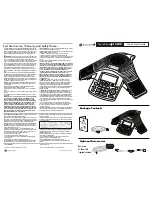
84
Ph
one
bo
ok
2
Select an entry
d
or
O
o
(
)
p
When the entry contains multiple phone numbers, or when you searched by “Mail
address?”, press
M
o
from the detailed display to select a phone number.
p
You can make a videophone call by pressing
l
(
).
Name?
You can enter the other party’s name from the first character and
search. You do not need to enter the full name.
Enter a part of the name
B
o
Phone number?
You can enter a part of the other party’s phone number and
search. You can search for the entry even from the middle of
phone number.
Enter a part of the phone number
B
o
p
You can display the Phonebook list also by entering a part of
the phone number from the Stand-by display or the “Talking”
display, and pressing
B
o
.
Mail address?
You can enter a part of the other party’s mail address and search.
You can search for the entry even from the middle of mail address.
Enter a part of the mail address
B
o
2-touch dial?
[FOMA phone only]
You can bring up the list of Phonebook entries in memory number
000 through 009.
p
Phonebook entries not yet stored or being set with secret are
displayed as
<−−−>
.
Item
Operation/Explanation
Information
p
In a search method other than “Group?” and “2-touch dial?”, enter nothing and press
+
B
o
; then you can search all through the Phonebook.
p
When no Phonebook entry is found that matches the condition you entered by
“Reading?” or “Memory No.?”, the entry that is the closest to the condition is displayed.
The Phonebook entries are searched in the order of readings you entered for storing, as
follows:
“Space at the beginning of the reading”
→
“Japanese syllabary (
ア、イ、ウ、エ、オ、... ン
)”
→
“Alphabet (A, a, B, b, ...Z, z)”
→
“Numerals (0 through 9)”
→
“Symbols”
→
“No reading”.
For “All?” and “Reading?”, searching is done in the following order:
“Japanese syllabary (
ア、イ、ウ、エ、オ、... ン
)”
→
“Alphabet (A, a, B, b, ...Z, z)”
→
“Space
at the beginning of the reading”
→
“Numerals (0 through 9)”
→
“Symbols”
→
“No reading”.
※
The Memory No. Search searches in the order of the memory numbers.
When you search from “All?”, “Reading?”, “Group?”, or
“Memory No.?”, the tabs appear on the top of the Phonebook
list. With “All?” and “Reading?”, the entries are sorted by every
column of reading, with “Memory No.?” by every 100 of the
memory number, and with “Group?” by every group.
Press
N
o
to display the Phonebook entries in the tab at left or
right. However, when there are seven or more Phonebook
entries in a tab, pressing
m
(
),
c
(
), or
<>
brings up the previous or next page.
p
After you search by “Reading?”, you can move the cursor to the “
ア
” through “
ワ
”, “
英
”,
and “
他
” tab by pressing each numeric key from the list. When you successively press
the same numeric key, you can move the cursor within the same column.
<Example>Press
5
to display the “
ナ
” tab. Each time you press
5
, the cursor
moves to the top of “
ニ
” “
ヌ
” and so on.
p
After you search by “Group?”, you can move the cursor to the top of each column in the
tab by pressing each numeric key from the list. When you successively press the same
numeric key, you can move the cursor within the same column.
<Example>Press
5
to move the cursor to the top of the “
ナ
” column. Each time you
press
5
, the cursor moves to the top of “
ニ
” “
ヌ
” and so on.
p
After you search by “Memory No.?”, you can move the cursor to the “000~” to “900~”
tab by pressing each numeric key from the list.
<Example>Press
5
to move the cursor to the “500~” tab.
Search order
About Phonebook List
Phonebook list
Summary of Contents for Style P-06A
Page 26: ...24...
Page 116: ...114...
Page 130: ...128...
Page 154: ...152...
Page 180: ...178...
Page 248: ...246...
Page 260: ...258...
Page 288: ...286...
Page 336: ...334...
Page 410: ...408...
Page 487: ...485 MEMO...
Page 488: ...486 MEMO...
Page 489: ...487 MEMO...
Page 490: ...488 MEMO...
Page 491: ...489 MEMO...
Page 492: ...490 MEMO...
Page 493: ...491 MEMO...
Page 494: ...492...
Page 495: ...493 Index Quick Manual Index 494 Quick Manual 502...
Page 561: ...Kuten Code List P 06A...
















































